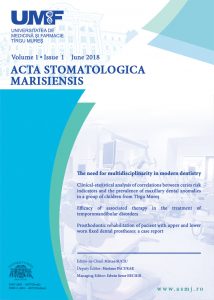Introduction: At present, the researchers are targeted to improve and increase the biocompatibility of dental materials that are in direct contact with biological tissues. The biocompatibility of the dental materials that contact the tissues of the oral cavity present relevance for the patient, clinician, dental technician, and manufacturer.
Aim of the study: The aim of this study was represented by the comparative research regarding the comfort of the patients wearing removable partial prostheses with clasps made of wire and flexible polymers.
Material and Methods. Patients wearing partial dentures from Meliodent heat-cured acrylic resins with wipla wire clasps, flexible partial dentures made from Valplast and dentures with clasps of CuSil silicone rubber participated in this study. The research was performed on 3 groups, of 8 patients each, in which comfort levels (according to 5 criteria) were determined, after 6, 12, 18, respectively 24 months of the partial removable prostheses insertion in the oral cavity.
Results. Presence of decubitus lesions of the oral mucosa in the clasps areas was noticed mostly in the Valplast polyamide dentures (37.5%), existence of color changes at the base of prostheses and of clasps area appeared in 37.5% of the third group (CuSil PAD) patients, no patient included in the study presented allergic reactions and at the third and fourth recall, only 1 patient of all groups complained of unpleasant taste in the oral cavity.
Conclusion. The removable prosthetic restorations with clasps made of flexible polymers and CuSil gaskets of silicone rubber, although initially much more comfortable and therefore much better accepted by patients, after two years were no longer active, could not be activated and necessited technical restorations, compared to those made of wipla wire clasps, which were activated with pliers, or, in the case of fracture, were replaced by the technician in the dental laboratory.
Farah Bechir 1, Ilinca Suciu 1
1 George Emil Palade University of Medicine, Pharmacy, Science, and Technology of Targu Mures
1 George Emil Palade University of Medicine, Pharmacy, Science, and Technology of Targu Mures

Comments are closed.